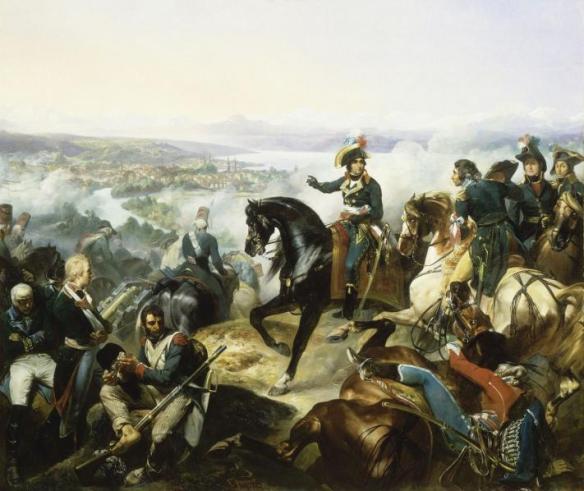François Bouchot. The Battle of Zurich, 25 September 1799 (Galerie des Batailles, Palace of Versailles)
Map showing the French positions in the Limmat Valley (1801)
Date
25–26 September 1799
Location
Zürich, Switzerland
Result
French victory
Belligerents
(1)France
(2)Austria
Russia
Commanders
(1)André Masséna
(2)Alexander Korsakov, Friedrich von Hotze
Strength
(1)75,000
(2)60,000
Casualties and losses
(1)Unknown
(2)22,000
Three months after the first battle of Zurich, a reinforced Marshal Massena’s found himself in another unenviable position of having to fend off vastly greater numbers of Russians under the legendary Field Marshal Suvarov. The French commander, however, acted with a Bonapartish style and, after sending a small force to slow Suvarov’s progress through the passes, rounded on the other Russian army under General Alexander Korsakov. He smashed into the Russians and scattered them, causing 8000 casualties and capturing supplies, baggage and cannons. Then, Massena turned on Suvarov and in a brilliant offensive operation drove him away – killing, wounding and capturing almost 14,000 Russians.
The Second Battle of Zürich (25-26 September 1799) was a French victory over an Austrian and Russian force near Zürich. It broke the stalemate that had resulted from the First Battle of Zürich three months earlier and led to the withdrawal of Russia from the Second Coalition.
Background
At the beginning of September 1799, Massena commanded approximately 75,000 men, deployed in a vast arc from Bale to the Saint Gotthard Pass. The bulk of his forces were on the Linth-Limmath line: Massena entrenched on the chain of the Albis, the left bank of the Lake of Zurich and the Limmath, Soult on the left bank of the Linth, and Lecourbe on the Reuss heights and at the Saint Gotthard Pass. In the rear, at the two extremities, Thureau guarded the Valais and Chabran covered Bale.
The Austro-Russians were divided into almost equal forces: Archduke Charles facing Massina on the right bank of the Limmath, Korsakov on the right bank of Lake of Zurich, and Hotze on the right bank of the Linth.
However, in the middle of September, the Aulic Council, which, from Vienna, directed all operations, decided that Archduke Charles should proceed to the Rhine and that Suvorov, arriving from Italy by the Saint Gotthard Pass, should replace him
After he had been forced out of the city in June, General André Masséna had fortified his position on the Zürichberg. General Korsakov’s Russians took control of the city. General Alexander Suvorov was also supposed to join forces, marching across the Gotthard pass, but Suvorov’s army was harassed by a small force sent by Masséna and did not reach Zürich in time. The coalition forces greatly outnumbered the French, so Korsakov sent more than half his force of around 60,000 men to cut off the French line of retreat.
Battle
Massena cleverly chose the moment to attack. Charles had left and Suvorov was yet en route and so the enemy forces amounted to only 55,000 men. On September 25, a group of his troops under Oudinot quickly crossed the Limmath at Closter-Fahr. On the 26th, a bloody battle was waged on the two banks of the river (Mortier remained on the left bank), up to the gates of Zurich, and within Zurich itself. He captured the city and a part of Korsakov’s army. At the same time, Soult attacked over the Linth, defeating Hotze, who was killed during the battle.
Masséna then rounded on the Austrian commanders with a brilliant offensive operation and drove their army away; killing, wounding and capturing almost 14,000 Austrians and Russians.
“Suvorov, who believed he was entering Switzerland on the flank of an enemy attacked from all sides, was going to discover, to the contrary, all his lieutenants dispersed and was going to engage the middle of a victorious army with many parts.” (Theirs.) Stopped at Airolo, Urseren, and the Diable bridge with the stubborn resistance of Lecourbe, he arrived at Altorf on September 26, the same day as the battle of Zurich, exhausted, without supplies, and having lost his artillery. Nevertheless, he continued his march and hurled himself at Massena in the direction of Schwyz. He tried to cross Mount Pragel but Molitor firmly held the pass of Kloen-Thal. He got stuck in the dreadful Engi valley and, after four days of unspeakable suffering, he finally reached Coire, after he had scattered along the route 11,000 of the 22,000 men that had entered Switzerland.
Aftermath
France was saved from an imminent invasion because Russia withdrew from the Second Coalition. The Helvetic Republic was weakened, losing its support among the population, leading to the Act of Mediation of 1803, partly restoring pre-revolutionary conditions.
